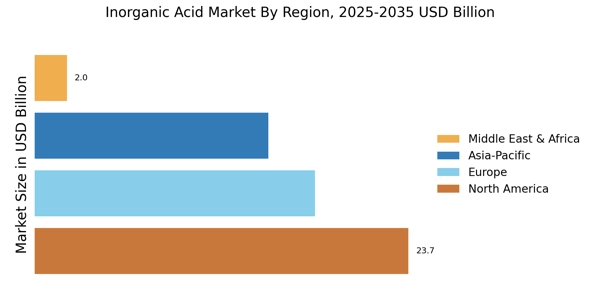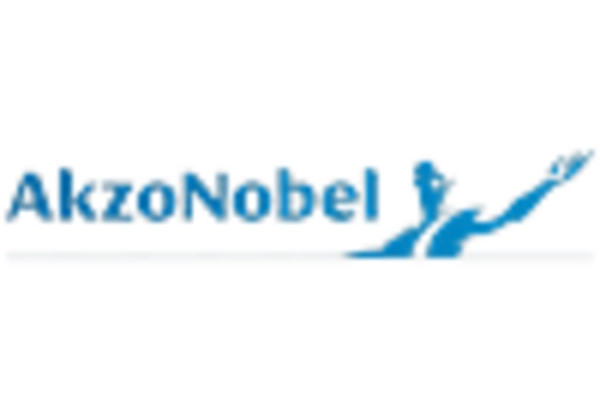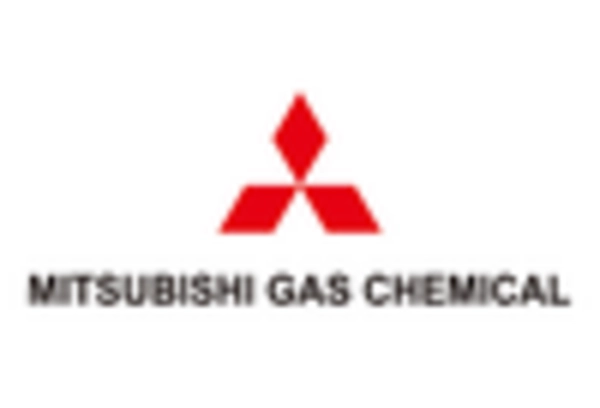Expanding Agricultural Sector
The agricultural sector's expansion significantly influences the Inorganic Acid Market, particularly through the demand for fertilizers. Inorganic acids, such as phosphoric acid and nitric acid, are crucial in producing nitrogen and phosphorus-based fertilizers. The Inorganic Acid Market is anticipated to grow steadily, with a projected CAGR of around 3.8% in the coming years. This growth is primarily driven by the increasing need for food production to meet the demands of a growing population. As farmers seek to enhance crop yields and soil health, the utilization of inorganic acids in fertilizers is likely to rise. Consequently, this trend is expected to create substantial opportunities for the Inorganic Acid Market, as manufacturers adapt to meet the evolving needs of the agricultural sector.
Environmental Regulations and Compliance
The Inorganic Acid Market is increasingly shaped by stringent environmental regulations and compliance requirements. Governments worldwide are implementing policies aimed at reducing emissions and promoting sustainable practices. Inorganic acids, while essential in various industrial processes, can pose environmental risks if not managed properly. As a result, industries are compelled to adopt cleaner production methods and invest in technologies that minimize the environmental impact of inorganic acid usage. This shift towards sustainability may lead to increased demand for eco-friendly inorganic acids and innovative production techniques. The market is likely to witness a transformation as companies strive to align with regulatory standards, thereby creating a more responsible Inorganic Acid Market that prioritizes environmental stewardship.
Technological Advancements in Production
Technological advancements play a pivotal role in shaping the Inorganic Acid Market. Innovations in production processes, such as the development of more efficient synthesis methods and improved purification techniques, are enhancing the quality and yield of inorganic acids. These advancements not only reduce production costs but also minimize waste and energy consumption. For instance, the implementation of membrane technology in acid production has shown promise in increasing efficiency. As industries seek to optimize their operations, the adoption of these technologies is likely to accelerate. The Inorganic Acid Market may experience a shift towards more sustainable and economically viable production methods, ultimately benefiting both manufacturers and consumers.
Rising Demand from Chemical Manufacturing
The Inorganic Acid Market experiences a notable surge in demand driven by the chemical manufacturing sector. Inorganic acids, such as sulfuric acid and hydrochloric acid, are essential in producing various chemicals, fertilizers, and plastics. The chemical manufacturing industry is projected to grow at a compound annual growth rate (CAGR) of approximately 4.5% over the next few years, which is likely to bolster the demand for inorganic acids. This growth is attributed to the increasing need for specialty chemicals and the expansion of production capacities. As manufacturers seek to optimize their processes, the reliance on inorganic acids is expected to intensify, thereby propelling the Inorganic Acid Market forward. Furthermore, the integration of advanced technologies in chemical production may enhance the efficiency of inorganic acid utilization, further solidifying its role in the industry.
Growing Demand in the Pharmaceutical Sector
The pharmaceutical sector's growth is emerging as a significant driver for the Inorganic Acid Market. Inorganic acids, such as hydrochloric acid and sulfuric acid, are utilized in various pharmaceutical applications, including drug formulation and synthesis. The Inorganic Acid Market is projected to expand at a CAGR of approximately 5.2% in the coming years, driven by an aging population and increasing healthcare needs. This growth is likely to enhance the demand for inorganic acids as pharmaceutical companies seek to develop new medications and improve existing formulations. As the industry evolves, the Inorganic Acid Market may witness increased collaboration between pharmaceutical manufacturers and inorganic acid producers, fostering innovation and ensuring a steady supply of essential raw materials.


















Leave a Comment